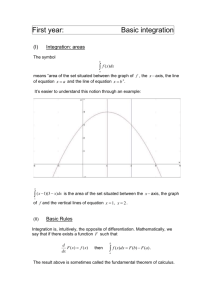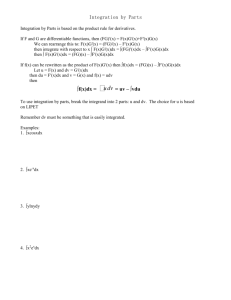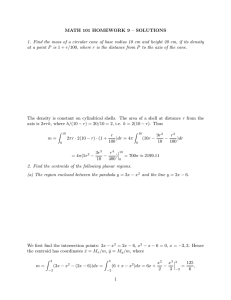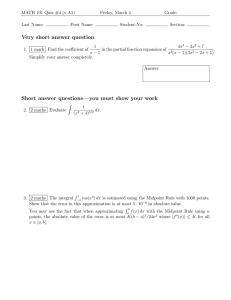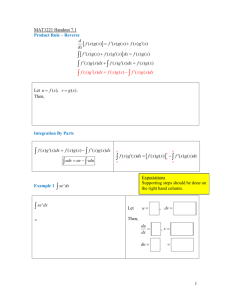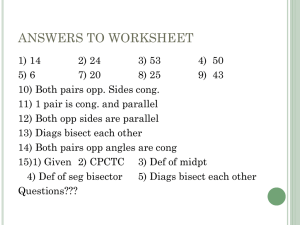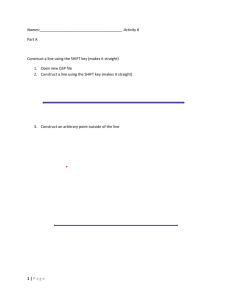Solutions to Suggested Problems Section 5.5
advertisement
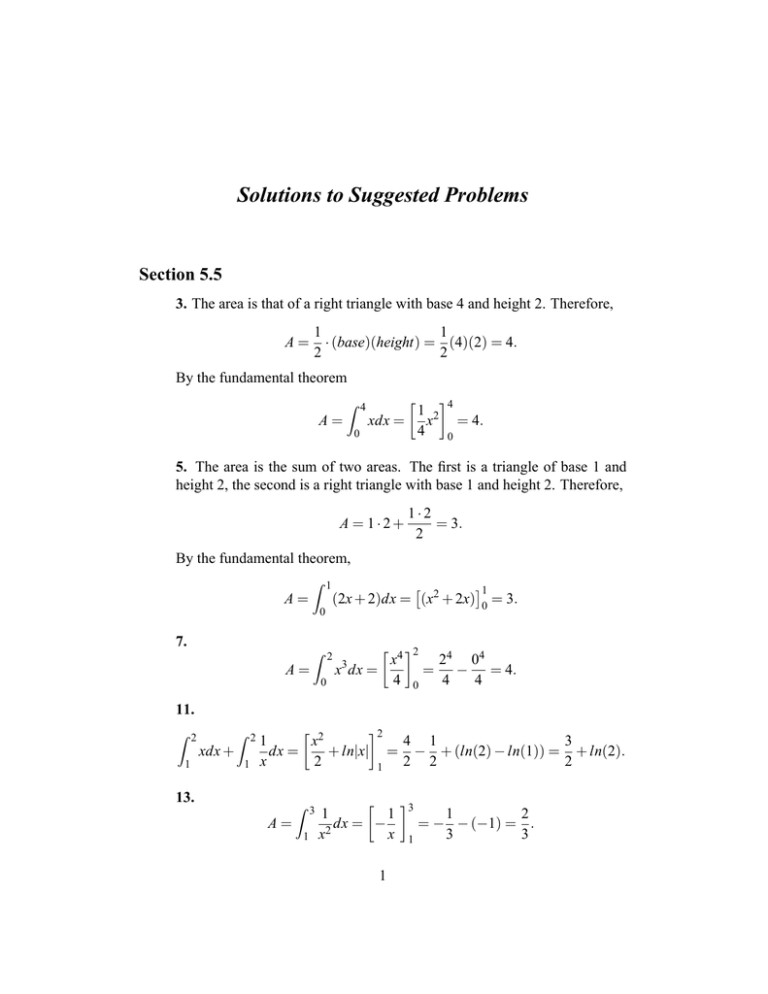
Solutions to Suggested Problems
Section 5.5
3. The area is that of a right triangle with base 4 and height 2. Therefore,
A=
1
1
· (base)(height) = (4)(2) = 4.
2
2
By the fundamental theorem
Z 4
A=
0
1
xdx = x2
4
4
= 4.
0
5. The area is the sum of two areas. The first is a triangle of base 1 and
height 2, the second is a right triangle with base 1 and height 2. Therefore,
A = 1·2+
1·2
= 3.
2
By the fundamental theorem,
Z 1
A=
0
1
(2x + 2)dx = (x2 + 2x) 0 = 3.
7.
Z 2
A=
0
x4
x dx =
4
3
2
=
0
24 04
− = 4.
4
4
11.
Z 2
xdx +
1
2
x2
4 1
3
dx =
+ ln|x| = − + (ln(2) − ln(1)) = + ln(2).
x
2
2 2
2
1
Z 2
1
1
13.
A=
1 3
1
2
= − − (−1) = .
dx = −
2
x
x 1
3
3
Z 3
1
1
1
15.
Z 1
A=
−1
ex dx = [ex ]1−1 = e − e−1 .
23.
Z 4
0
1
(x − 4x )dx = x5 − x4
5
4
3
4
256
1 5
4
4 4
−1 = −
.
= 4 −4 = 4
5
5
5
0
27.
Z 1
−2x
e
−1
1
1
1 −2x 1
= − (e−2 − e2 ) = (e2 − e−2 ).
dx = − e
2
2
2
−1
33. Let u = ln(x) and dv = xdx. Then du = 1x dx and v = 12 x2 , so
Z
1
1
xln(x)dx = x2 ln(x) −
2
2
Z
1
1
xdx = x2 ln(x) − x2 + c.
2
4
Therefore,
Z 2
1
1
1
xln(x) = x2 ln(x) − x2
2
4
2
1
= (2ln(2) − 1) − −
4
1
3
= 2ln(2) − .
4
37. Let u = x2 + 1. Then du = 2xdx or xdx = 12 du. Therefore,
x
1
dx
=
x2 + 1
2
1
1
1
du = ln|u| + c = ln(x2 + 1) + c.
u
2
2
1
R
and we obtain 01 x2x+1 dx = 12 ln(x2 + 1) 0 = 12 ln(2). Since f (x) > 0 in
(0, 1), the area is also equal to 12 ln(2).
Z
Z
39. Let u = ln(x) and dv = dx. Then du = 1x dx and v = x, so that
Z
ln(x)dx = xln(x) −
Z
1
· xdx = xln(x) − x + c = x(ln(x) − 1) + c.
x
Therefore, 12 ln(x)dx = [x(ln(x) − 1)]21 = 2(ln(2) − 1) − (0 − 1) = 2ln(2) −
1. Since f (x) > 0 in (1, 2) the area is also equal to 2ln(2) − 1.
R
2
41. By the fundamental theorem of calculus,
Z 2
f (x)dx = F(2) − F(−1) = 3 − 5 = −2.
−1
3
45. Since A(t) = 1t f (x)dx = t3 + 16ln(t) − 13 , it follows from Theorem
16
2
5.5.2 that f (t) = A0 (t) = t 2 + 16
t , so that f (x) = x + x .
√
47. G0 (t) = t 2 − 3t + 5 by Theorem 5.5.2.
R
49.
Zt
Z t
4
d
d
2 x4
2 x4
G (t) =
t + x e dx = 1 +
x e dx = 1 + t 2 et .
dt
dt
0
0
0
R
√
√
51. Let F(u) = 1u ex xdx. By Theorem 5.5.2, we have F 0 (u) = eu u.
Since G(t) = F(t 2 ), the chain rule gives
G0 (t) =
2√
2
d
d
F(t 2 ) = F 0 (t 2 ) · (t 2 ) = et t 2 · 2t = 2t|t|et .
dt
dt
55. Let S(t) be the amount of annual sales (in millions of dollars) t years
after 2000. Then S0 (t) = r(t) = 1, 000 − 10t 2 , which means that the change
of sales from 2000 to 2010 is given by
Z 10
S(10)−S(0) =
0
10, 000 20, 000
10 3 10
=
.
= 10, 000−
(1, 000−10t )dt = 1, 000t − t
3
3
3
0
2
Since S(0) = 800, we have S(10) = 800 + 20,000
≈ 7, 466.67 million dollars.
3
57. The profit function is of the form
Z
P(x) =
(−0.2x + 50)dx = −0.1x2 + 50x + c.
The initial condition P(100) = 1, 500 gives −1, 000 + 5, 000 + c = 1, 500,
or c = −2, 500. Therefore, P(x) = −0.1x2 + 50x − 2, 500.
3
Section 5.6
1.
Z 10
−0.1t
e
0
10
1
−0.1t 10
−1
dt = −10e
.
= −10e −(−10) = − +10 = 10 1 −
0
e
e
5. Let u = ln(x), then du = 1x dx. When x = 1, we have u = ln(1) = 0, when
x = e, we have u = ln(e) = 1. Therefore
Z 1
Z e
1 3 1 1
(ln(x))2
2
dx =
u du = u
= .
x
3
3
0
1
0
9. Let u = t + 9. Then du = dt. When t = 0, we have u = 0 + 9 = 9, and
when t = 7, we have u = 7 + 9 = 16. Therefore,
16
Z 7
Z 16
Z 16
t
2 3/2
u−9
1/2
−1/2
1/2
√
√ du =
dt =
(u − 9u
)du =
u − 18u
u
3
t +9
0
9
9
9
2
20
=
· 64 − 18 · 4 − (18 − 18 · 3) = .
3
3
13. Let u = x2 − 16. Then du = 2xdx or xdx = 12 du. When x = 4, we have
u = 0, and when x = 5 we have u = 9. Therefore,
9
Z 5 p
Z 9
√
1
1
1
3/2
= · 93/2 = 9.
x x2 − 16dx =
udu = u
3
3
4
0 2
0
19. f (x) − g(x) = (4 − x2 ) − 3 = 1 − x2 ≥ 0 for 0 ≤ x ≤ 1. Therefore,
f (x) ≥ g(x) for 0 ≤ x ≤ 1, and
Z 1
Z 1
1 3 1 2
2
= .
Area =
[ f (x) − g(x)]dx =
(1 − x )dx = x − x
3 0 3
0
0
23. f (x)−g(x) = 2x2 −(x3 −3x) = −(x3 −2x2 −3x) = −x(x−3)(x+1) ≥ 0
for 0 ≤ x ≤ 3. Therefore, f (x) ≥ g(x) for 0 ≤ x ≤ 3, and
3
3
Z 3
Z 3
2x
x4 3x2
2
3
Area =
[ f (x) − g(x)]dx =
(2x − x + 3x)dx =
− +
3
4
2 0
0
0
81 27 45
= 18 − +
= .
4
2
4
4
33. To find the intersection points, we set x2 + x + 1 = −2x2 + 4x + 7, which
reduces to 3(x−2)(x+1) = 0, whose solutions are x = −1 and x = 2. Moreover, (x2 + x + 1) − (−2x2 + 4x + 7) = 3(x − 2)(x + 1) ≤ 0 for −1 ≤ x ≤ 2.
The area is
Z 2
2
2
[(−2x + 4x + 7) − (x + x + 1)]dx =
−1
Z 2
(−3x2 + 3x + 6)dx
−1
=
3x2
+ 6x
−x +
2
3
2
=
−1
27
.
2
37.
1
2 − 21
2
Z 2
2
10
10
1
dt =
·5
dt =
ln|t|
= (ln(2) − ln(1/2))
t
3
3
3
1/2 t
1/2
10
20
=
(ln(2) + ln(2)) = ln(2).
3
3
Z 2
5
1/2
41. Write
1
x2 −5x+4
=
1
(x−1)(x−4)
gives 1 = A(x − 1) + B(x − 4), so
1
8−5
Z 8
5
B
A
x−4 + x−1 . Clearing
A = 13 and B = − 31 .
=
the denominators
Z 1 8 1/3
1/3
1 x − 4 8
1
dx =
−
dx = ln x2 − 5x + 4
3 5 x−4 x−1
9 x − 1 5
1
4
1
1 16
=
ln − ln
= ln .
9
7
4
9 7
47. The slope is given by y0 (x) = 3x2 , and its average over [0, 2] is
Z
1 3 2
1 2 2
3x dx = x
= 4.
2 0
2 0
On the other hand, the slope at x = 0 is 0, and the slope at x = 2 is 12. The
average of these numbers is 6, which is not the same as the average slope
computed above. Since 3x2 is not linear, we should not expect the averages
to be the same.
51.
1
24
Z 24
0.05t
(2, 500e
0
50, 000 0.05t
)dt =
e
24
5
24
=
0
6, 250 1.2
(e − 1) ≈ 4, 833.58.
3
Section 5.7
2
1. (a) The integration interval is [0, 1], ∆x = 1−0
5 = 0.2, and f (x) = x . Then
f 00 (x) = 2 and the maximum value of | f 00 (x)| on [0, 1] equals 2. The error
3
1
using the midpoint rule satisfies EM ≤ 2(1−0)
= 300
. The error using the
2
24·5
trapezoidal rule satisfies ET ≤
2(1−0)3
12·52
=
1
150 .
(b) The values of the function
at the midpoints are in the table below
R1 2
The midpoint rule gives 0 x dx ≈ 0.2(0.01 + 0.09 + 0.25 + 0.49 + 0.81) =
x
x2
0.1
0.01
0.3
0.09
0.5
0.7
0.25 0.49
0.9
0.81
0.33.
The values of the function at the endpoints are in the table below:
The trapezoidal rule gives
x
x2
Z 1
x2 dx ≈
0
0
0
0.2
0.04
0.4
0.6
0.16 0.36
0.8
0.64
1
1
0.2
(0 + 2 · 0.04 + 2 · 0.16 + 2 · 0.36 + 2 · 0.64 + 1) = 0.34
2
Since 01 x2 dx = 31 x3 |10 = 13 , the actual error for the midpoint rule is |0.33 −
1
1
1
1
3 | = 300 , and the actual error for the trapezoidal rule is |0.34 − 3 | = 150 .
R
3. (a) The integration interval is [0, 2] and ∆x = 2/5. The function values at
the midpoints are in the table below:
The midpoint rule gives
x
1
x+1
Z 2
0
1/5
5/6
3/5
5/8
5/5
5/10
7/5
5/12
9/5
5/14
2 5 5 5
5
5
1 1 1 1 1 459
(x+1)−1 dx ≈ ( + + + + ) = + + + + =
≈ 1.0929.
5 6 8 10 12 14
3 4 5 6 7 420
6
To estimate the error, we compute f 00 (x) = 2/(x + 1)3 . On the interval [0, 2],
f 00 (x) is positive and achieves a maximum of 2 at x = 0. Therefore, the error
2
2·23
satisfies EM ≤ 24·5
2 = 75 ≈ 0.0267.
(b) Since f (x) = 1/(x + 1), we have f 00 (x) = 2/(x + 1)3 and the maximum
value of | f 00 (x)| on [0, 2] is 2, achieved at x = 0. Therefore,
EM ≤
2 · (2 − 0)3
2
= 2.
2
24n
3n
To make this less than 0.001, n must satisfy the inequality n2 ≥ 2000
3 or
p
n ≥ 2000/3 ≈ 25.8. Thus, n = 26 will insure that EM < 0.001. If n = 26,
1 3
51
then ∆x = 1/13 and the midpoints are { 26
, 26 , ..., 49
26 , 26 }. The midpoint rule
gives
Z 2
(x + 1)−1 dx ≈ 2 · (
0
1
1
1
1
+ + ... + + ) ≈ 1.0984.
27 29
75 77
(c) With n = 26, the actual error is |ln3 − 1.0984| ≈ 0.0002.
4. The integration interval is [0, 8]. If we let n = 4 and ∆t = 2, the function
values at the midpoints in the table below.
(a) By the midpoint rule, the total distance travelled during that time period
t
1
r(t) 32
3
39
5
7
38 32
is approximately 2 · (32 + 39 + 38 + 32) = 282 miles.
(b) The antelope’s average speed is
1R
8
r(t)dt ≈
282
8
= 35.25 mph.
5. The area of the surface of the river from x = 3 to x = 6 equals
Z 6
A=
(
3
1
1
+ 1 − 1/2 )dx
1/2
(x − 2)
x
The integration interval is [3, 6], and ∆x = 6−3
6 = 0.5. The function values
at the midpoints are in the table below:
By the midpoint rule, A ≈ 0.5 · (1.3397 + 1.2395 + 1.1816 + 1.1442 +
1.1183 + 1.0994) = 3.5613 hundred square feet.
7
x
3.25
N(x) − S(x) 1.3397
3.75
1.2395
4.25
1.1816
4.75
1.1442
5.25
1.1183
5.75
1.0994
9. If n = 6, the ∆x = 0.5. The endpoints are {−1, −0.5, 0, 0.5, 1, 1.5, 2} and
the midpoints are {−0.75, −0.25, 0.25, 0.75, 1.25, 1.75}. The midpoint rule
gives 1.8994, and the trapezoidal rule gives 1.8788.
16. The integration interval is [0, 4], n = 4 and ∆x =
zoidal rule,
Z 4
0
4−0
4
= 1. By the trape-
1
f (x)dx ≈ [0.1 + 2 · 0.4 + 2 · 0.5 + 2 · 1 − 0.1] = 1.9.
2
17. To estimate 010 v(t)dt, we enter the function values at t = 1, 2, ...9 as a
sequence, say L1 . Then take the sum of the terms, and, finally, add 12 (0 +
140) = 70, to get 530.
R
8
